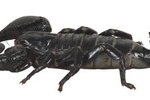
Salamanders come in plenty of types, each with their own standards for proper care. But they all share common needs. If you plan on raising a pet salamander, you must understand these needs beforehand. These creatures are not necessarily as personable as other reptiles, and treating them as you would another pet can have fatal consequences.
Types of Habitats
The type of habitat you provide for a pet salamander depends on his type -- the vendor from whom you acquire your new pet can tell you what to expect. Generally, salamanders are either aquatic, semi-aquatic or terrestrial -- this determines how much water they need in their habitat. Terrestrial salamanders, for example, require moist, soft substrate like potting soil that they can burrow in and only a dish of water. No matter the type, your salamander's habitat should be as similar as possible to his natural environment, well-ventilated, placed away from direct sunlight and kept between 55 and 65 degrees Fahrenheit.
Feeding Your Salamander
Feed your pet salamander once a day -- preferably at night, as they are nocturnal creatures. This reptile eats a variety of small insects such as worms, slugs and crickets. Portion guidelines are dictated by how much a captive salamander eats in a single meal, which varies by individual. Leave uneaten portions in the tank and wait until your salamander finishes everything before feeding him again, then reduce his portion to reflect how much he consumes at once. Provide him with a dish of fresh spring water daily.
Look, Don't Touch
Unlike reptiles such as snakes, which you may handle, salamanders should never be in direct contact with your skin. Your skin is coated in natural oils that can be fatally poisonous to your salamander, and holding him even for a few minutes can be dangerous for him. Should you need to remove him from the tank for tank-cleaning or travel, scrub your hands in soap and hot water, carefully rinsing off all traces of the soap. Scoop your salamander up in a small fishnet to move him rather than pick him up directly. If you happen to touch him while corralling him into and out of the net, he should be fine, because you washed your hands just prior.
Care and Cleaning
Every two to three months, remove the salamander from his tank and place him in another so you can thoroughly clean his habitat. Dump out old substrate and water, and scrub out the inside of the tank with warm water. Do not use cleaning products like bleach, which can leave harmful chemical traces -- instead, use a mild detergent and thoroughly rinse the aquarium before replacing the substrate and reintroducing your salamander.
References
Photo Credits
-
Hemera Technologies/AbleStock.com/Getty Images
Writer Bio
Tom Ryan is a freelance writer, editor and English tutor. He graduated from the University of Pittsburgh with a degree in English writing, and has also worked as an arts and entertainment reporter with "The Pitt News" and a public relations and advertising copywriter with the Carnegie Library of Pittsburgh.



